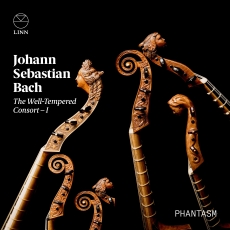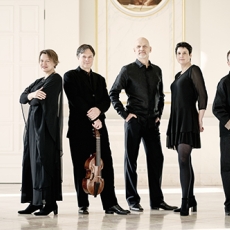Phantasm - J.S. Bach: The Well-Tempered Consort – I - Andrew Benson-Wilson Blog
This CD could well become essential listening for all organists and harpsichord players, alongside the various examples of Bach organ works played on recorder consorts. Transferring Bach’s keyboard works, such as The Well-Tempered Clavier, Musical Offering and Clavier-Übung III, to a viol consort reveals the sensitivity of timbre possible with bowed string instruments rather than a plucked or wind-blown one. Of course, keyboard players have their own, often complex, way of imparting musical expression to their playing within the limitations of their particular instrument, principally by using aspects of touch and articulation. But it is only the clavichord, which was arguably the instrument of choice in the Baroque era, that has the ability to change the nature of the sound of a note once it has started sounding, using the technique known as bebung which imparts a controllable vibrato to sounding notes.
Phantasm has its roots in the English 17th-century repertoire of Byrd, Dowland, Jenkins, Lawes, Locke, and Tye. The rather intense and insular sound world of those composers would appear to be far removed from the later Baroque of Bach. Their aim with this recording is “to uncover the riches concealed behind the more neutral resources of the harpsichord and organ so as to liberate characters lurking in the shadows of Bach’s polyphonic edifices.”. The result is generally succesful, although occasionally speeds can appear a little fast and/or with a slight feeling of rhythmic instability.
One issue to which only prior listening will give reassurance, or otherwise, is whether you feel tha the wide range of expression used in four or more individual voices is really the most useful way to present polyphony. In the original keyboard settings, there would be relatively little difference between the timbre of each of the voices, but this is far from the case in these performance. Phantasm play with more expression than many similar viol consorts, often leaning into and out of notes, and it does affect the stability of the tone of each instrument and its position in the polyphonic structure.
Final chords reveal another major difference with organ or, to a lesser extent, harpsichord performances. In organs tuned in non-equal temperaments, the final chords (or other earlier longer held chords) are usually moments of repose, where everything seems to stand still. In equal temperament, you can a continuous undercurrent of acoustic beats, giving an unsettling feeling to the sound. To an extent, the same affect applies in these performances, not through tuning, but through the individual expressive devices used, including pitch-vibrato which many would consider anachronistic for this repertoire. Apart from any historial performance issues, this is probably an matter of personal taste, so listen to a few samples online to see what you think.
Nine of the 20 pieces are transposed into more viol-friendly keys, negating the effect of the different key colours, particularly of the Well-Tempered Clavier. But with viols being fretted instruments, that is probably inevitable, whatever the key – it is suprisingly rare to see split-frets on viols. Only four of the pieces are longer than four minutes, one being the famous ‘St Anne’ organ Fugue that concludes Clavier-Übung III, here played in D major. Like many organists, they play the middle section too fast in relation to the outer two sections and the rhythmic pulse that should underlie the whole piece – although they balance that by also playing the final section too fast.
Those points aside, one positive point is that they respect Bach’s endings, which are often rather notated as rather short, with marked rests completing the final bar. They are usually ignored in performance, particularly by organists.
It was recorded in the Jesus-Christus-Kirche in Dahlem in south-west Berlin. It is a large modern building with far more resonance than would be usual with viol music, although the recording focus deals with this potential issue well, whilst retaining a background acoustic bloom. Phantasm are the core members Laurence Dreyfus, Jonathan Manson, Emilia Benjamin, Heidi Gröger and Markku Luolajan-Mikkola with Liam Byrn joining them for the two 6-part pieces.

